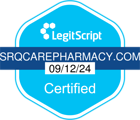Anti-Aging Compounding
By Brittany A Duke, PharmD
Medically reviewed by Rosanna Sutherby, PharmD
Do you agree that your skin changes with age and that these changes can sometimes make you look older than you are? Fortunately, there’s hope! Compounding pharmacists can provide anti-aging treatments to help you stop the effects of aging. Read on to learn:
- Why you need anti-aging compounding
- What are common anti-aging treatment methods
- What are some common anti-aging compounded ingredients
Why Do You Need Anti-Aging Compounding?
You might have noticed that wrinkles, age spots, and dry skin start to appear as you age. Your skin can also lose fat and stop retaining moisture, which may slow down healing when your skin is injured or damaged.
Sunlight can be a critical factor in your skin’s aging by causing damage known as photoaging. Years of exposure to UV light and artificial UV sources can increase the risk for photoaging on the most visible parts of your body, such as your face, neck, upper chest, and back of your hands.
Dead skin cells can cause wrinkles and loss of elasticity. Your skin renews itself frequently by shedding dead skin cells. Every month your skin replaces dead skin cells with new ones through a process called skin cell turnover. After around age 50, your skin cell turnover rate slows down to roughly once every 45 to 90 days. The build-up of dead skin cells on your skin surface can make your skin appear dull.
Collagen and elastin are proteins in your skin that work together to give your skin its texture and shape. Collagen helps strengthen and hydrate your skin and gives it elasticity. Elastin helps your skin bounce back to its natural form after being touched or poked. Collagen and elastin fibers make up the supporting components of the skin. However, your body produces less collagen and elastin as you age, and your skin begins to wrinkle and sag.
What are Common Anti-Aging Treatment Methods?
The following are common anti-aging treatments used to hydrate dry skin and preserve a youthful appearance:
Hyaluronic Acid
Hyaluronic acid (HA) is found naturally in your skin. It retains water to help your skin stay hydrated, and it promotes faster healing. You can use HA as a supplement or as an injectable skin filler.
Dermal Fillers
Dermal fillers are gel-like products that restore volume, smooth and fill creases and lines, and enhance the curves of your face. Dermal fillers can give you a more youthful look when they are injected into the area around your nose, mouth, and cheeks.
Chemical Peels
A chemical peel typically involves applying a mild acid, such as alpha-hydroxy acid, to your skin to peel off the top layer. This exfoliation reveals new smoother and firmer skin.
Serums for Wrinkle Reduction
Compounded serums can help promote new collagen production and reduce the look of wrinkles and fine lines on your skin.
Anti-Aging Creams
Compounded anti-aging creams combined with sunscreens can help diminish signs of aging in your skin caused by reduced collagen production and slowed cell turnover.
What Are Some Common Anti-Aging Compounded Ingredients?
Compounded anti-wrinkle serums can include the following active ingredients:
- Estrogen: Estrogen works to moisturize your skin and improve your skin’s firmness and elasticity.
- Vitamin E: Vitamin E can be combined with melatonin to reduce the development of lines on your skin.
- Retinol palmitate: Retinol palmitate brings volume to your face and decreases wrinkles by promoting collagen production.
- Melatonin: Melatonin protects your skin from sun damage and slows the aging process.
- DHEA (Dehydroepiandrosterone): DHEA works to hydrate and brighten your skin and add thickness to your skin.
Compounded anti-aging creams can include the following active ingredients:
- Estrogen: Estrogen helps to moisturize your skin.
- Vitamin E: Vitamin E acts as an antioxidant to help reduce sun damage.
- Retinol molecular film: Retinol molecular film is a form of vitamin A. It can protect your skin against sun damage, promote cellular growth, and make your skin more elastic and youthful-looking.
- Sodium hyaluronate: Sodium hyaluronate encourages collagen production, adds elasticity to your skin, and helps retain moisture in your skin.
- Collagen hydrolysate: Collagen hydrolysate helps your skin regenerate and look tighter and smoother by promoting the growth of collagen fibers and delaying elastin fiber breakdown.
Summary
Your compounding pharmacist can add vitamins and antioxidants to your moisturizers to address your unique needs in keeping your skin healthy and young. If you are concerned about sun damage, consider compounding formulations with sunscreens and moisturizers. These compounds can help preserve your skin’s natural health and glow and maintain a youthful look.
About Author:
Dr. Brittany A Duke is a Pharmacist and freelance health writer with over 5 years of experience in medical writing. Prior to her new position as a Global Regulator Manager for Bristol Myers Squibb, she worked at the FDA for 4 years. At the FDA, she was a Medical Writer for the Office of Surveillance and Epidemiology, Division of Medication Error Prevention and Analysis, Rapid Response Team. There, she was responsible for the development of regulatory documents including guidance, regulations, policies, and procedures that affect the drug approval or post market product safety surveillance and evaluation process.
References:
- Herndon JH Jr, Jiang LI, Kononov T, Fox T. An Open Label Clinical Trial to Evaluate the Efficacy and Tolerance of a Retinol and Vitamin C Facial Regimen in Women with Mild-to-Moderate Hyperpigmentation and Photodamaged Facial Skin. J Drugs Dermatol. 2016;15(4):476-482. https://jddonline.com/articles/dermatology/S1545961616P0476X/2
- Knaggs H. Skin Aging in the Asian Population. In: Dayan N. Skin Aging Handbook. William Andrew Publishing; 2009:177-201. https://www.sciencedirect.com/topics/pharmacology-toxicology-and-pharmaceutical-science/retinol-palmitate. Accessed June 30, 2021.
- Lee C, Bajor J, Moaddel T, et al. Principles of Moisturizer Product Design. J Drugs Dermatol. 2019;18(1s): s89-s95. https://jddonline.com/articles/dermatology/S1545961619S0089X
